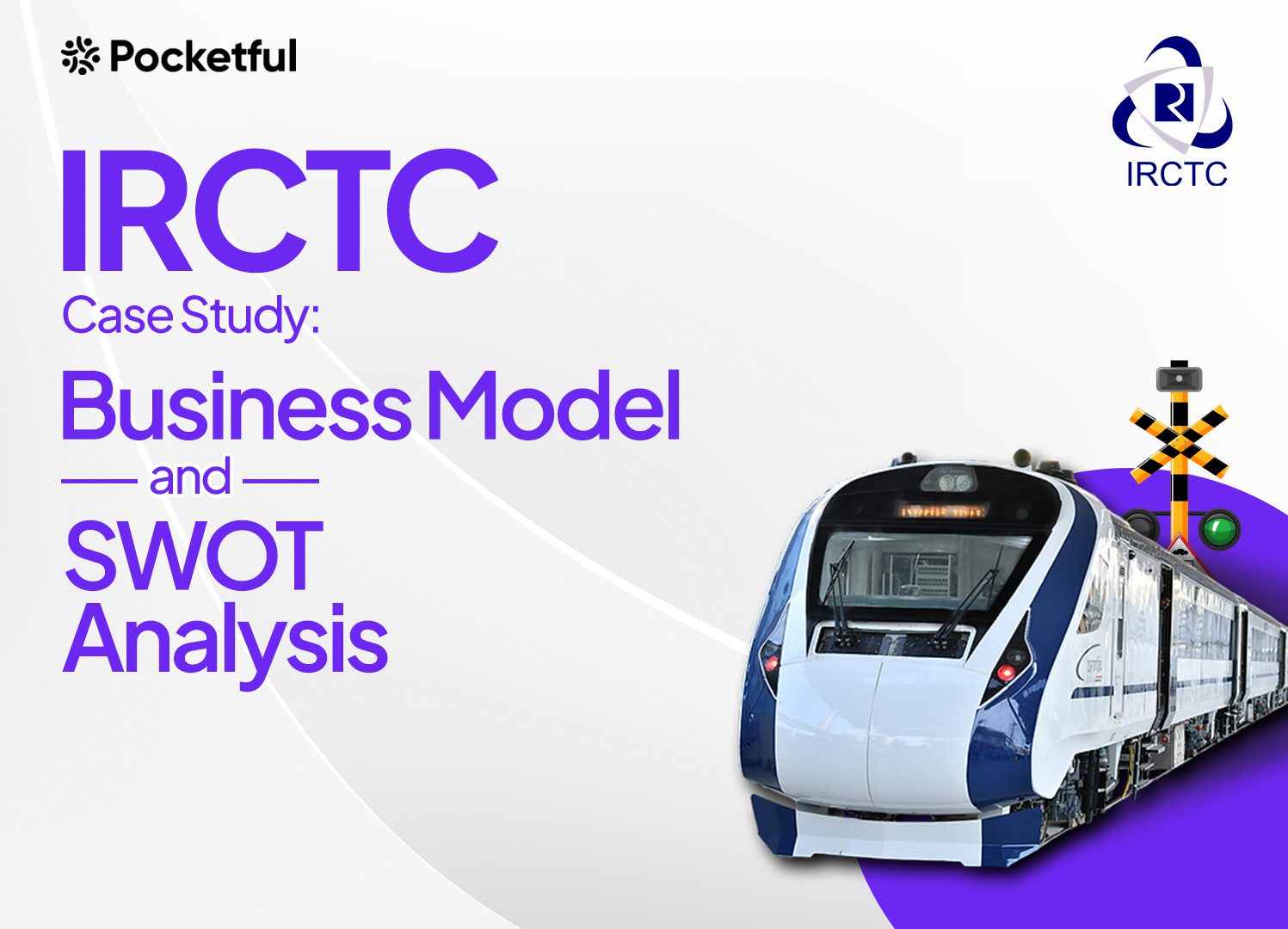| Type | Description | Contributor | Date |
|---|---|---|---|
| Post created | Pocketful Team | Mar-22-24 | |
| Update Formatting | Nisha | Feb-27-25 | |
| Update Formatting | Nisha | Feb-27-25 |

- Blog
- irctc case study business model financials and swot analysis
IRCTC Case Study: Business Model, Financials, and SWOT Analysis

Are you interested in identifying monopolies? In today’s blog, we’ll explore a company that roams unrivalled in the market, IRCTC.
What makes this firm unique, and whether investing in a PSU company is worthwhile? So read on to get all the answers and put an end to any confusion you may have.
IRCTC Overview
Established under the Ministry of Railways, IRCTC stands for Indian Railway Catering and Tourism Corporation of India. It is a public sector organization.
IRCTC, the company’s online ticketing gateway, was launched in 2002 and allows customers to purchase tickets online. Subsequently, they began providing catering services and managed food and beverage services on trains and at railway stations, broadening their capabilities beyond online ticketing. As a result of technology advancements and a rise in smartphone usage, IRCTC has released a mobile application that serves as an easy-to-use platform for users to book tickets, check train schedules, and access other services.
Since investors view IRCTC as the most coveted PSU stock, the company decided to list on Indian stock exchanges in 2019. The government’s share of the business was reduced to 87% following the IPO.
Did you know?
The Indian government designated IRCTC as a “Mini Ratna” public corporation in May 2008.

IRCTC Business Model
Let’s dive deeper into each of its business segments.
1. Catering & Hospitality – Railway stations, passenger trains, and station premises are among the several areas where food and hospitality operations are dispersed. They provide e-catering, static catering, and mobile catering services.
2. Internet ticketing – They empower regular people with technology through their online ticket booking system. Indian Railways has permitted just one company to provide online ticket booking services.
3. Packaged Drinking Water – To meet the needs of travellers, they introduced Rail Neer as a reliable and safe packaged drinking water.
4. Travel & Tourism – India is thought to have some of the best landscapes on earth, and IRCTC is always trying to promote travel by providing trip packages.
Revenue Contribution
Of the four main IRCTC business areas, online ticketing makes up approximately 63% of overall revenue, followed by catering services at roughly 22%, rail network, travel and tourism, and rail at roughly 8% and 7%, respectively.
Market Details
| Current Market Price | INR 909 |
| Book Value | INR 33 |
| 52 Week High | INR 1049 |
| 52 Week High Date | 20-Jan-24 |
| 52 Week Low | INR 557 |
| 52 Week Low Date | 29-March-23 |
| Face Value of Share | INR 2 |
| PE Ratio | 65.26 |
| Market Capitalization | 72175 Crores |
Read Also: Zaggle Case Study: Business Model, Financials, and SWOT Analysis
Financial Highlights
Balance Sheet
| Particulars | 31st March 2023 | 31st March 2022 | 31st March 2021 |
|---|---|---|---|
| Non-Current Asset | 736.1103 | 506.1311 | 446.3389 |
| Current Asset | 4352.6485 | 3331.04 | 2724.94 |
| Total Asset | 5088.7588 | 3884.0923 | 3153.1789 |
| Equity | 2478.4041 | 1870.3136 | 1455.8114 |
| Long Term Liability | 218.9893 | 215.8769 | 159.1085 |
| Current Liability | 2391.3654 | 1784.6307 | 153.8259 |
The graph presented above shows that the company’s total assets have grown from 3884.04 crore in FY 2022 to 5088.75 crore in FY 2023, while its long-term liabilities have remained unchanged. Additionally, the company’s current assets have increased exponentially from 3331 crores in FY 2022 to 4352 crores in FY 2023.
Income Statement
| Particulars | 31st March 2023 | 31st March 2022 | 31st March 2021 |
|---|---|---|---|
| Revenue from operations | 3541.4729 | 1878.5744 | 776.6577 |
| Total Income | 3661.9034 | 1954.4782 | 861.6415 |
| Total Expenses | 2335.0938 | 1065.0970 | 643.5259 |
| Profit before tax | 1354.0096 | 885.3767 | 257.5137 |
| Profit after tax | 1005.8811 | 659.5529 | 187.0264 |
According to the company’s income statement, its annual revenue has grown by almost 88%. Consequently, its expenses have also doubled for FY 2023 compared to FY 2022.
Cash Flow Statement
| Particulars | 31st March 2023 | 31st March 2022 | 31st March 2021 |
|---|---|---|---|
| Net Cash flow from operating activities | 810.1224 | 523.9714 | 247.5385 |
| Cash flow from investing activities | (315.1356) | (242.3862) | (452.8751) |
| Cash flow from financing activities | (434.3454) | (258.4055) | (46.8471) |
The table above illustrates that the company’s cash flow from financing and investing activities has consistently been negative for the last three years, while its cash flow from operating activities has increased year over year.
KPIs
| Particulars | 31st March 2023 | 31st March 2022 | 31st March 2021 |
|---|---|---|---|
| Operating Profit Margin (%) | 37.91 | 48.12 | 29.32 |
| Net Profit Margin (%) | 28.40 | 35.31 | 24.25 |
| Return on Capital Employed (%) | 49.78 | 44.07 | 14.10 |
| Inventory Turnover | 8.63 | 5.55 | 119.73 |
| Current Ratio | 1.82 | 1.87 | 1.77 |
| Return on Net Worth (%) | 40.58 | 35.22 | 12.94 |
According to the KPI for the business, the company’s operating profit margin and net profit margin are inconsistent. However, the current ratio, which indicates the company’s liquidity, has improved compared to FY 2022, and the return on capital employed has increased over the previous three years.
SWOT Analysis of IRCTC

Strengths
1. When it comes to offering Indian Railways online ticketing services via their website and mobile application, IRCTC essentially has a monopoly.
2. The organization offers a wide range of products, including travel, catering, other services, and tickets.
3. Among train passengers, IRCTC is considered a trusted brand.
4. Since it is an Indian government subsidiary, it offers them a stable working environment.
Weaknesses
1. IRCTC frequently receives complaints from patrons over the food they provide and the restricted selection of options on their menu.
2. IRCTC’s responsive system and agility are hampered by inefficiencies in its system.
3. They do not adequately promote their trip package-related marketing initiatives.
Opportunities
1. IRCTC can expand the range of services it offers, including digital payments, lodging, and travel insurance.
2. By providing appealing international travel packages, the organization can make a name for itself in the global market.
3. Providing consumers with local and regional delicacies can help them become more satisfied customers.
4. They can provide ready-to-eat meals and a corporate canteen through their catering service.
Threats
1. The company may lose its monopoly and market share if it privatises the Indian railways.
2. As we have seen, the tour and travel business has experienced significant setbacks in 2020 due to COVID-19. If further incidents of this nature occur, their profitability will inevitably decline.
3. Any changes to laws or policies about the food safety sector will immediately affect the company’s earnings.
Read Also: Titan Case Study: Business Model, Financials, and SWOT Analysis
Conclusion
The Ministry of Railways allowed IRCTC a monopoly to sell tickets online, which has helped to fuel its expansion. The business’s income and earnings have consistently increased. IRCTC constantly seeks to innovate to improve the customer experience while diversifying its business.
There is no turning back for this mini-ratna company to become one of India’s prosperous enterprises as long as the government maintains its beneficial policies. If you are looking to invest in this company, then you should check your risk profile before making any decision.
Frequently Asked Questions (FAQs)
Is IRCTC a government company?
Yes, IRCTC was established in the year 1999 as a public sector company owned by the government of India under the Ministry of Railways.
Who are the promoters of IRCTC?
The President of India is the promoter of IRCTC and accounts for about 62.4% of the company’s total equity.
Is IRCTC a profitable company?
Yes, IRCTC is a profitable company, and the firm’s profit for FY 2023 was 1005 crores.
Who is the Managing Director of the IRCTC?
Mr. Sanjay Kumar Jain is the company’s chairman and managing director.
How is IRCTC a monopoly company?
The government of India has provided them with a monopoly over selling online railway tickets, packaged drinking water, and catering services on trains and railway stations across the country.
Disclaimer
The securities, funds, and strategies discussed in this blog are provided for informational purposes only. They do not represent endorsements or recommendations. Investors should conduct their own research and seek professional advice before making any investment decisions.